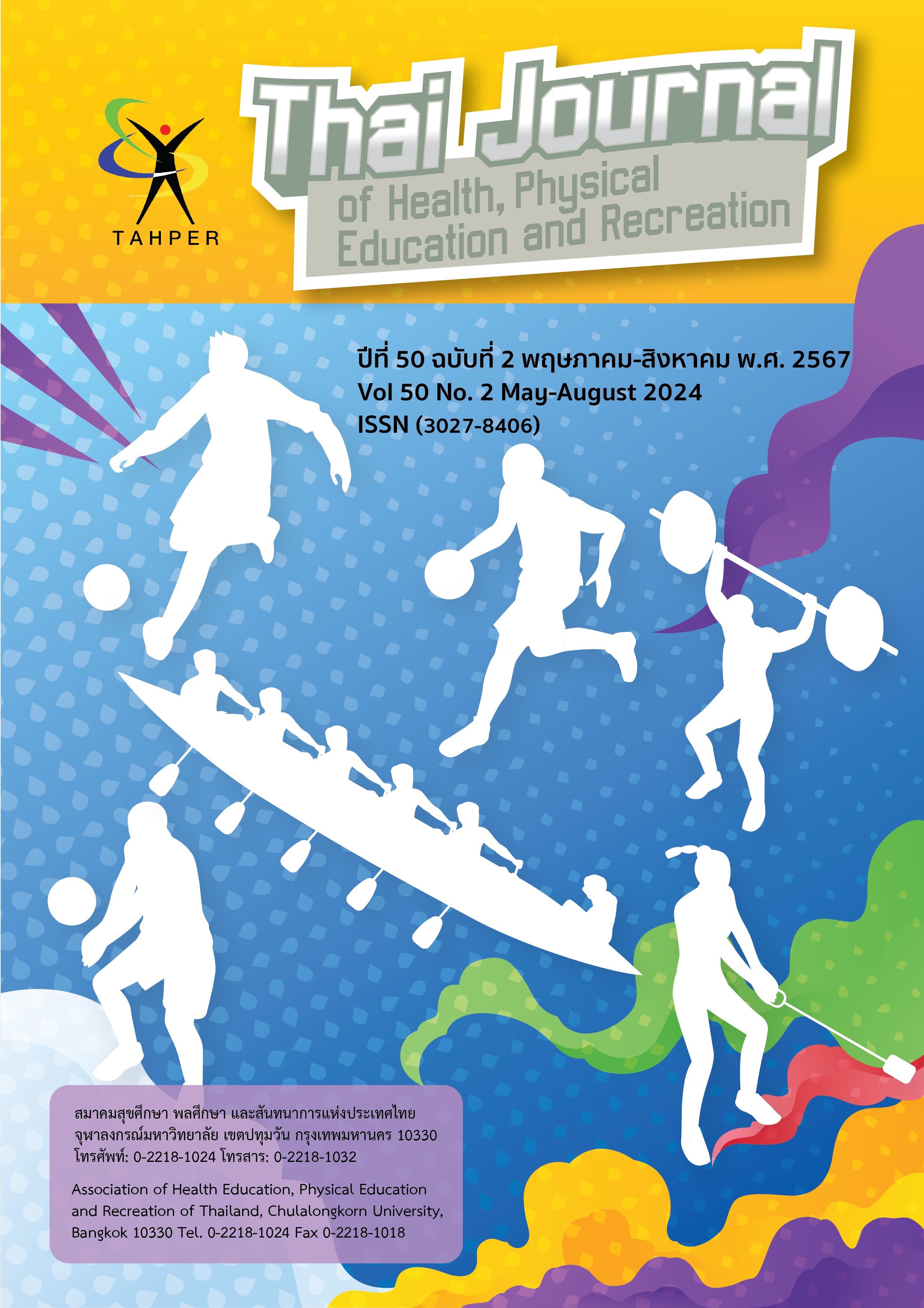Effects of Recovery patterns on Heart Rate after Exercise
Main Article Content
Abstract
The purposes of this research were to study the recovery patterns 1, 2 and 3 on the heart rate after exercise and to compare the heart rate after exercise among the recovery patterns 1, 2 and 3. The samples were 20 male Kasetsart University football athletes who aged 19-22 years old. They were participated in the Thailand Prime Ministers Cup 2020 and were selected by a purposive sampling method. The research instruments were PWC 170 and three recovery patterns developed by the researcher and approved for face validity by 5 experts. Data were analyzed by means, standard deviation, One Way ANOVA and One Way ANOVA repeated measure. The results were as follows:
1. The average of heart rate after exercise at minute 1, 5 and 10 within the three recovery patterns: pattern 1, setting physical activity at 50% of the heart rate reserve with cooling for 5 minutes and cooling only for another 5 minutes 2) setting physical activity at 50% of the heart rate reserve for 5-minute, after that cooling for 5 minutes 3) sitting with cooling for 5 minutes and then drinking cold water for 5 minutes were statistically significant difference at the .05 level. 2. The average of the heart rate after exercise among 3 recovery patterns found that for the 3rd patterns, sitting for cooling and drinking cold water for 10 minutes after exercise at minute 1, and minute 5 were statistically significant difference at the .05 level but at minute 10 were not statistically significant difference at the .05 level
Article Details

This work is licensed under a Creative Commons Attribution-NonCommercial-NoDerivatives 4.0 International License.
Critical thinking in journals is the right of the author. The Association of Health Education, Physical Education and Recreation of Thailand is not always required, to create diversity in ideas and creativity.
ความคิด ข้อวิพากษ์ในวารสารเป้นสิทธิของผู้เขียน สมาคมสุขศึกษา พลศึกษา และสันทนาการแห่งประเทศไทยไม่จำเป็นต้องเห็นชอบด้วยเสมอไป เพื่อให้เกิดความหลากหลายในความคิดและความสร้างสรรค์
References
เจริญ กระบวนรัตน์. (2557). วิทยาศาสตร์การฝึกสอนกีฬา. กรุงเทพมหานคร: บริษัท สินธนาก๊อปปี้ เซ็นเตอร์ จำกัด.
ชูศักดิ์ เวชแพทย์ และกันยา ปาละวิวัธน์. (2536). สรีรวิทยาของการออกกำลังกาย. (พิมพ์ครั้งที่ 4). กรุงเทพฯ: ธรรกมลการพิมพ์.
ฐาปนา ถาวร. (2562). การเปรียบเทียบรูปแบบการฟื้นตัวหลังการออกกำลังกายในช่วงเวลาพักที่มีต่ออัตราการเต้นของหัวใจในนักกีฬาฟุตซอล. วิทยานิพนธ์ศิลปศาสตรมหาบัณฑิต สาขาวิชาพลศึกษา, มหาวิทยาลัย เกษตรศาสตร์.
ณัฐชนนท์ ซักพุง. (2557). ผลของรูปแบบการฟื้นสภาพภายหลังออกกำลังกายที่มีต่อระดับความเข้มข้นของกรดแลคติกและอัตราการเต้นของหัวใจในนักกีฬาฟุตบอล. วิทยานิพนธ์ศิลปศาสตดุษฎีบัณฑิต สาขาวิชาพลศึกษา, มหาวิทยาลัยเกษตรศาสตร์.
ไพรัช เลิศเกียรติศักดิ์. (2527). เปรียบเทียบการฟื้นตัวหลังการออกกำลังกาย ระหว่างวิธีการดื่มน้ำเย็น การชโลมน้ำเย็นและการนั่งพักในห้องอุณหภูมิต่ำ. วิทยานิพนธ์ครุศาสตรมหาบัณฑิต สาขาวิชาพลศึกษา, จุฬาลงกรณ์มหาวิทยาลัย.
เรวัติ สุดาจันทร์, อําพร ศรียาภัย และสุพิตร สมาหิโต (2565). ผลเฉียบพลันของการยืดกล้ามเนื้อแบบอยู่กับที่แบบเคลื่อนที่ และแบบกระตุ้นการรับรู้ระบบประสาทกล้ามเนื้อ ที่มีต่ออาการเจ็บระบมกล้ามเนื้อ. วารสารสุขศึกษา พลศึกษา และสันทนาการ, 48(1), 99-110.
วิชากร เฮงษฎีกุล. (2564). ปัจจัยที่ส่งผลต่อความสําเร็จในอาชีพนักกีฬาฟุตบอลหญิงในประเทศไทย. วารสารครุศาสตร์ มหาวิทยาลัยราชภัฏมหาสารคาม, 18(3), 127-137.
วันดี ขาวโอภาส. (2542). การเปรียบเทียบระยะฟื้นตัวหลังการออกกำลังกาย โดยวิธีดื่มน้ำธรรมดากับเครื่องดื่มเกลือแร่. วิทยานิพนธ์ศิลปศาสตรมหาบัณฑิต สาขาวิชาพลศึกษา, มหาวิทยาลัยเกษตรศาสตร์.
สุดาวรรณ วุฒิชาติ และณัฐิกา เพ็งลี (2565). ผลของการฝึกแบบหนักสลับเบาด้วยรูปแบบการวิ่งหลายทิศทางที่มีต่อสมรรถภาพการใช้ออกซิเจนและสมรรถภาพแบบไม่ใช้ออกซิเจน ในนักกีฬาแบดมินตันรุ่นเยาวชน. วารสารสุขศึกษา พลศึกษา และสันทนาการ, 48(1), 24-35.
สุภาพร โกเมนเอก. (2551). การเปรียบเทียบผลของการฟื้นตัวหลังการออกกำลังกายด้วยวิธีการต่าง ๆ ต่อประสิทธิภาพในการทำงานของร่างกายในนักกีฬา. วิทยานิพนธ์วิทยาศาสตรมหาบัณฑิต สาขาวิชาวิทยาศาสตร์การกีฬา, จุฬาลงกรณ์มหาวิทยาลัย.
สมบัติ อ่อนศิริ. (2542). การเปรียบเทียบอัตราการเต้นของหัวใจในระยะฟื้นตัวในท่านั่งและท่านอน. วิทยานิพนธ์ศิลปศาสตรมหาบัณฑิต สาขาวิชาพลศึกษา, มหาวิทยาลัยศรีนครินทรวิโรฒ.
สมบัติ อ่อนศิริ. (2562) พลังงานกับการออกกำลังกาย. กรุงเทพมหานคร: บริษัท วิสต้าอินเตอร์ปริ้นท์ จำกัด.
อิสริยา ทองห่อ. (2559) ผลของวิธีการฟื้นตัวภายหลังการออกกำลังกายที่มีต่อกรดแลคติกในเลือดอัตราการเต้นของหัวใจและสมรรถภาพเชิงแอนแอโรบิกในนักกีฬา. วิทยานิพนธ์วิทยาศาสตรมหาบัณฑิต สาขาวิชาวิทยาศาสตร์การออกกำลังกายและการกีฬา, มหาวิทยาลัยบูรพา
Cengiz, A. M. (2015). Effects of self-selected dehydration and meaningful rehydration on anaerobic power and heart rate recovery of elite wrestlers. The Society of Physical Therapy Science, 27(5), 1441-1444.
Jinnah, A. H., Luo, T. D., Mendias, C., & Freehill, M. (2019). Cryotherapy duration is critical in short-term recovery of athletes: a systematic review. Journal of ISAKOS, 4(3), 131-136.
Macnab, R. B., Conger, R. P., & Taylor, P. S. (1969). Differences in maximal and submaximal work capacity in men and women. Journal of Applied Physiology, 27(5), 644-648.
The international football association board. (2019). Laws of the Game 2019/20. Zurich: n.p.
Wilcock, I. M., Cronin, J. B., & Hing, W. A. (2006). Physiological response to water immersion: a method for sport recovery. Sports Med, 36(9), 747-765.


